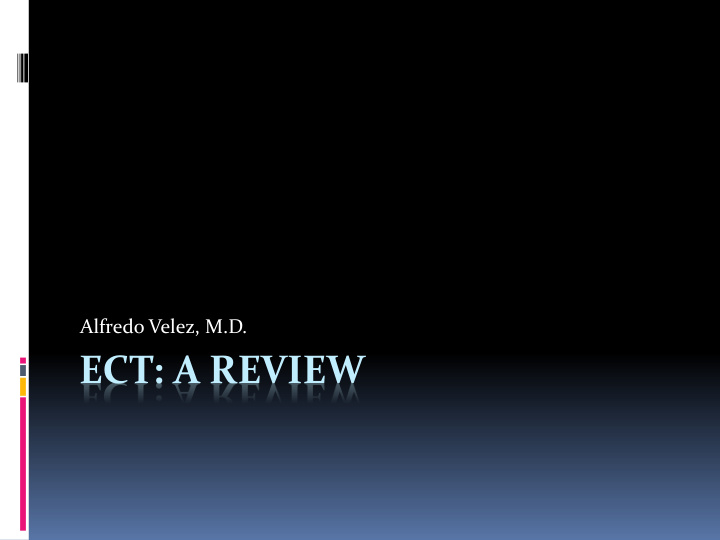



Alfredo Velez, M.D. ECT: A REVIEW
Nothing to Disclose
ECT is not a treatment of last resort!!!
History Experiments with medical electricity begin in 18 th Century (!) 1934 – Chemical convulsive therapy, camphor, metrazole Hungarian Neuroscientist Ladislas Joseph von Meduna Based on theory of medical antagonism – seizures vs psychosis 1937 – Electrical convulsive therapy Italian neuropsychiatrists Cerletti and Bini Easier seizure induction, ability to regulate
History (cont.) Decline begins in 1950’s Introduction of effective pharmacotherapy Negative media portrayal
History (cont.) Decline levels off in 1980’s Modest resurgence – 100,000 pts receive ect/year
Sample Case An 82-year-old widowed woman with a history of recurrent unipolar major depression is referred to the electroconvulsive therapy (ECT) service of an academic medical center. During her illness, she has had four episodes of major depression consisting of periods of depressed mood, crying spells, loss of interest in usual activities, insomnia, loss of appetite and weight, difficulty with concentration, feelings of helplessness and hopelessness, and thoughts of suicide. During the current episode, which has lasted for 6 months, she has had typical symptoms of melancholic depression, as well as psychotic symptoms (e.g., a somatic delusion that she has terminal cancer), with suicidal ideation and a plan for taking a drug overdose. Previous treatment during this episode has included citalopram (Celexa), duloxetine (Cymbalta), and the combination of olanzepine (Zyprexa) and duloxetine, but the patient did not have a response to any of these agents. She could not tolerate the anticholinergic side effects of tricyclic antidepressants. Her psychiatrist seeks specialty consultation regarding the appropriateness and safety of ECT for this patient.
Mechanism Seizure – induced by electricity Length and quality linked to efficacy Increased cortical GABA concentrations Enhances serotonergic function affects the hypothalamic–pituitary–adrenal axis, normalizing the results of the dexamethasone suppression test
Indications Depression – especially catatonic or psychotic Antidepressant response rates for the first agent administered can be as low as 50% Antidepressants take significant time to begin working Elderly or medically compromised patients may not be able to tolerate medication APA guidelines: 1) poor response or intolerance to meds 2) Previous response to ECT 3) Need for fast response Intractable mania Schizophrenia with catatonic features
Contraindications There are no absolute contraindications to ECT!!! Relative contraindications: Unstable cardiac disease, recent cerebral hemorrhage or stroke, or increased intracranial pressure Less efficacy: prolonged depressive episode, personality disorder Can be used in patients with pacemakers and pregnant patients
Pre ECT evaluation Psychiatric H+P – delineate need for ECT Anaesthesia evaluation Risk factors: Intercranial mass lesion, cardiovascular disease, recent stroke, pulmonary conditions Note that none are absolute contraindications EKG for patients over 40 or with cardiac disease CBC, CMP Assess meds, take all except theophylline, anticonvulsants, benzos, diabetic meds; avoid concomitant use of lithium (controversial) Informed consent
Technique Anaesthesia with general anaesthetic (e.g. brevitol ) and paralytic (e.g. succinylcholine) Low doses of both Patient unconscious for 2-3 minutes Bag mask ventilation Ankle BP cuff technique
Technique (cont.) Electrode placement – bilateral vs right unilateral Impedance test EEG monitoring EKG monitoring O2 sat monitoring Electrical stimulus – 3-6 seconds, adjustable energy 6-12 treatments, 3 times a week IP vs OP
ECT Device MECTA Spectrum 5000Q
Efficacy 70-80% !!!!!!! Rapid efficacy Especially effective in psychotic depression as well as depression in the elderly Better than pharmacotherapy or psychotherapy Only an acute therapy, must initiate pharmacotherapy to prevent relapse
Side Effects Cognitive effects: Anterograde amnesia, worse with bilateral electrode placement Retrograde amnesia, especially of events temporally close to treatment Post ictal confusion or (rarely) delirium, usually less than 1 hr duration Headaches, muscle aches, nausea, fatigue No evidence of anatomical brain damage Very safe – about 2 deaths per 100,000 procedures
Return to sample case Reasons to select ECT in this patient lack of a response to or intolerance of adequate trials of antidepressant medications and neuroleptic agents presence of suicidal ideation with a plan requires rapid treatment response psychotic subtype Considerations for this patient Combine ect w/ pharmacotherapy Taper off ECT Start with unilateral electrode placement Consider maintenance ECT
Summary Not a treatment of last resort! High efficacy Rapid response Consider ECT in depressed patient with psychosis or catatonia Be aware of side effects No absolute contraindications!
Recommend
More recommend